Learn more about how VOC can benefit your business.
Many companies, both large and small, do not take the time to talk to customers directly. Before spending large sums of money on developing products, innovators need to be sure that it reflects the voice of the customer (VOC) and what customers want.
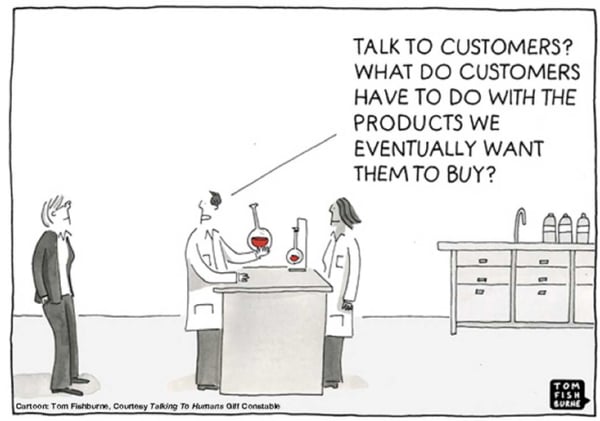
A comic on VOC irony
The voice of customer process is a market research technique that seeks to capture the customer’s expectations, likes, and dislikes. Not only will the VOC process allow you to figure out a customer’s stated requirements or needs, but it should also help you figure out unstated ones as well. The VOC process also allows the company to determine customer ‘pain points’ with the current market standard, whether that be direct competition or the way customers are getting the job done today. Listening to the customer will also give your company insight on how consumers make decisions when going to buy a particular product, and whether or not a client changes their preferences over time.
The idea that preferences change over time is especially significant in the context of the COVID-19 pandemic. Consumer preferences change daily based on conditions, including income and environment It is important for a company to constantly check in with customers to ensure their product is meeting consumer’s needs.
A lot of companies do not take advantage of contacting their customers these ways. Using VOC can allow you to stay in tune with the critical (and not so critical) desires of your customers.
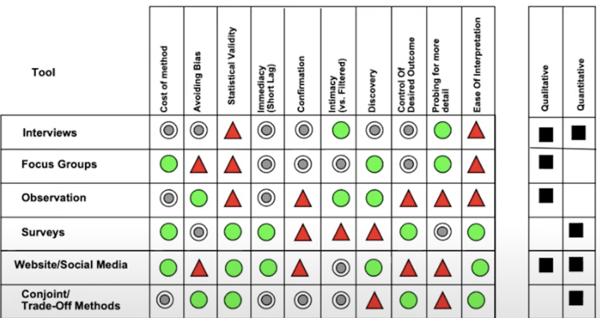
Green is favorable, Red is unfavorable, and Grey is Neutral.
The grid above is a great indicator for the strengths and weaknesses of different types of VOC collection techniques. This table is from the opinions of Dr. Richard Creager. The second grid (on the right) shows how data can be collected, either quantitatively or qualitatively. Quantitative means that the data can be put into numbers and figures. Qualitative generally means it can not, like interview answers.
One positive thing about the top 3 rows is that interviews, focus groups, and observations can generally be done in person (or on video conferencing). This means you can respond to customers more organically and even read body language.
Before you start out with the Voice of Customer (VOC) process, you need to ask yourself “Who is my customer?” Customers are generally defined as a person or function that will make the purchasing decision on your product. These people/groups will be the ones to pay your company directly.
For example, if you are selling a medical device, you may think that the surgeon is your customer. This can be true in many cases, especially if the surgeons themselves are the business owners. But, in some cases the surgeons will not be the direct customer. It could be the Chief Medical Officer of a large hospital or other officials that do not directly work with the product, like the Chief Financial Officer. Below is a graphic with a few key customers in the medical field.
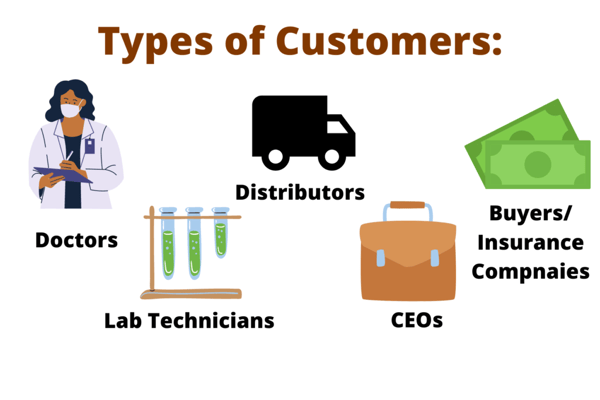
Comprehensive VOC will take all of these people’s opinions and preferences into account, not just the person who is writing the check.
The Voice of Customer process involves a great deal of planning and pre-planning before you are even able to begin collecting data. Below is a chart that outlines a typical VOC process.
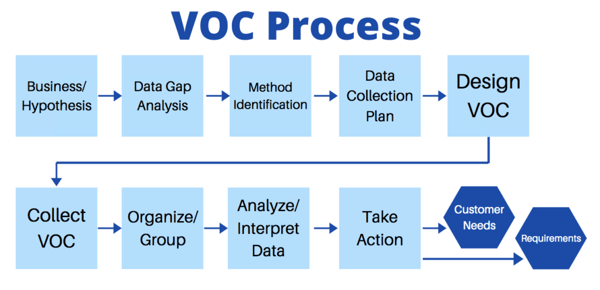
Pre Planning involves developing a hypothesis that you wish to test Many times this will be along the lines of “The current market standard is not what a customer would prefer given our option.” Planning will involve deciding between the different types of data collection. Consulting with large groups of customers right off the bat is generally unwise; you want a plan to implement at certain steps before you start interviewing customers.
The final steps involve analyzing the data. Now that you have heard the customer’s complaints or suggestions, how will you implement them into your company’s product? The 2 conclusions that generally come out of the VOC process are customer needs and product requirements. OFten you will need to do multiple rounds of VOC to truly understand the customer’s needs and the essential product requirements.
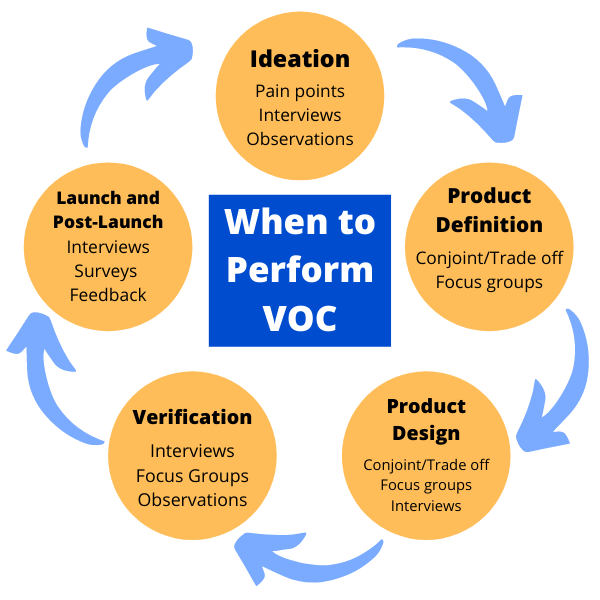
VOC is an ongoing process in any successful company. The graph above can demonstrate how VOC can shift throughout different steps in a product’s development. If a company has multiple products or services, the VOC process should be constantly revolving (sometimes at different rates) for each. Many companies perform VOC once during product development and once before the product launch to ensure that customer’s needs have been met.
It is important not only for companies to carry out VOC, but to truly analyze the customer’s opinions and implement them in their product. Many companies believe they know best, or are unwilling to budge on certain features of a product, but if the customer does not like them that company will have a hard time selling that product. Not only does VOC help in product development, but also customer retention. Creating a satisfied pool of consumers can help grow your company and its reputation. VOC can be used to gauge an existing customer’s interest and satisfaction as to ensure maximum retention.
Using VOC in this current pandemic will also allow you to understand how a customer’s needs and pain points have shifted in 2020. Companies that implement these changes and are willing to grow from the virus will have a higher chance of thriving.
Customer interviews are one of the best forms of VOC, because you are able to see their body language as well as hear their opinions aloud. If you choose to conduct interviews, many companies interview around 20-50 people, with around 50-100 customers generating statistically significant results. Usually, the more the better.
Interviews allow a deeper understanding of the customer because it allows them to respond in their own words. Additionally, interviews allow the interviewer to ask additional questions that come about organically. Usually you would conduct an interview face to face, but with today’s pandemic it is common to perform these interviews online. Recruiting methods can differ based on region, but the best way to find interviewees is to network and talk to someone who has done it before. What has worked for them?

Sometimes it can be hard as a business owner not to be incharge of the conversation or to stop talking, but it is important that the customers control the conversation here. While interviewing, you should try to avoid yes/no questions, and always ask open ended questions. Throughout the interview you should adjust the questions you originally wrote to fit the flow of the conversation. It is normal not to get through all of your questions! Creating a question guide is important, but you should not be reading from or staring at it the whole time; make it natural!
Try to avoid talking about your product to the customer. If you describe it to them before they answer the market questions, you could introduce bias into the interview process. Make sure they answer the questions before you tell them about their product. You aren’t trying to sell it! You are trying to learn about the average customer’s likes, dislikes, and preferences.
A lot of times companies will provide gift cards to people who complete the interviews, to places like Amazon or a grocery store. The up front cost may seem intimidating, but it is better to understand the customer early on rather than after a product launch has failed (an you have wasted much more money than the VOC cost).
The whole idea in asking these questions is to find out what product or service they are using today, and whether or not your product could replace the standard.
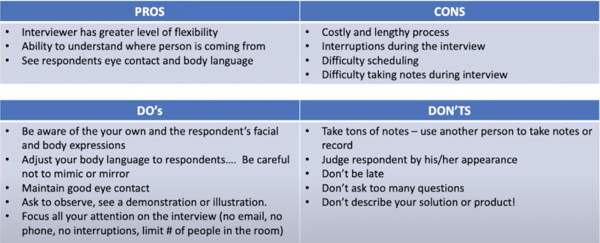
The Do's/Don'ts and Pros/Cons of VOC interviews.
Interview 5 customers
Assess learnings
Assess question validity - are you getting the information you need?
Revised questions and interview the next 5 customers
Repeat on the next groups, revising if needed
This sample process can help you build upon your experience with
Remember that you are in business for your customers, whomever they may be. You want to listen to what they have to say about your product, not just what you think about it.
It is better to spend a little money on VOC before spending millions of dollars developing something that no one wants! And last, but not least, VOC never ends; it should be constantly happening to gauge customer interest and market trends.
If a company has a concept or idea, and they are thinking of starting a business, they should start VOC. It will even help an entrepreneur understand whether or not to go forward with this idea at all!
Writing surveys is both an art and a skill. It is very easy to write questions that are biased on SurveyMonkey, so it should generally be avoided. SurveyMonkey can be used as a follow up, but interviewing customers or using the other processes above is a better bet.
An easy technique to use if you are coming out of a university is to day “I am doing research for University XYZ and I am interested in finding out more about how you do ABC.” It is probably smart not to mention the company’s name as to not introduce bias.
No, you should focus on your questions without giving any backstory. It is harder for someone to give you the truth about your product when they think they could be hurting your personal feelings or company’s desires.
Sometimes you can, and sometimes you might want new people. It depends whether or not you got through all of your questions with an individual the first time and if you have anything new to ask them. Developing a relationship with one (or more) individual customers will help you.
This information in this article is from a webinar hosted University Lab Partners in partnership with the Small Business Development Center (SBDC) @ UCI Beall Applied Innovation, presented by Richard Creager, a business consultant at SBDC @ UCI Beall Applied Innovation.
Richard is a life science and tech commercialization expert. He is interested in using his passion to influence organizations in board assignments and consulting arrangements.
Stay connected with ULP by connecting with us on LinkedIn, and subscribe to our Youtube Channel to be the first to see new webinars!
Revised 11/18/2020
Download The Ultimate Guide to Wet Lab Incubators in Southern California, a handbook to assist life science start-ups through the entire decision-making process to find wet lab space.
Download Now